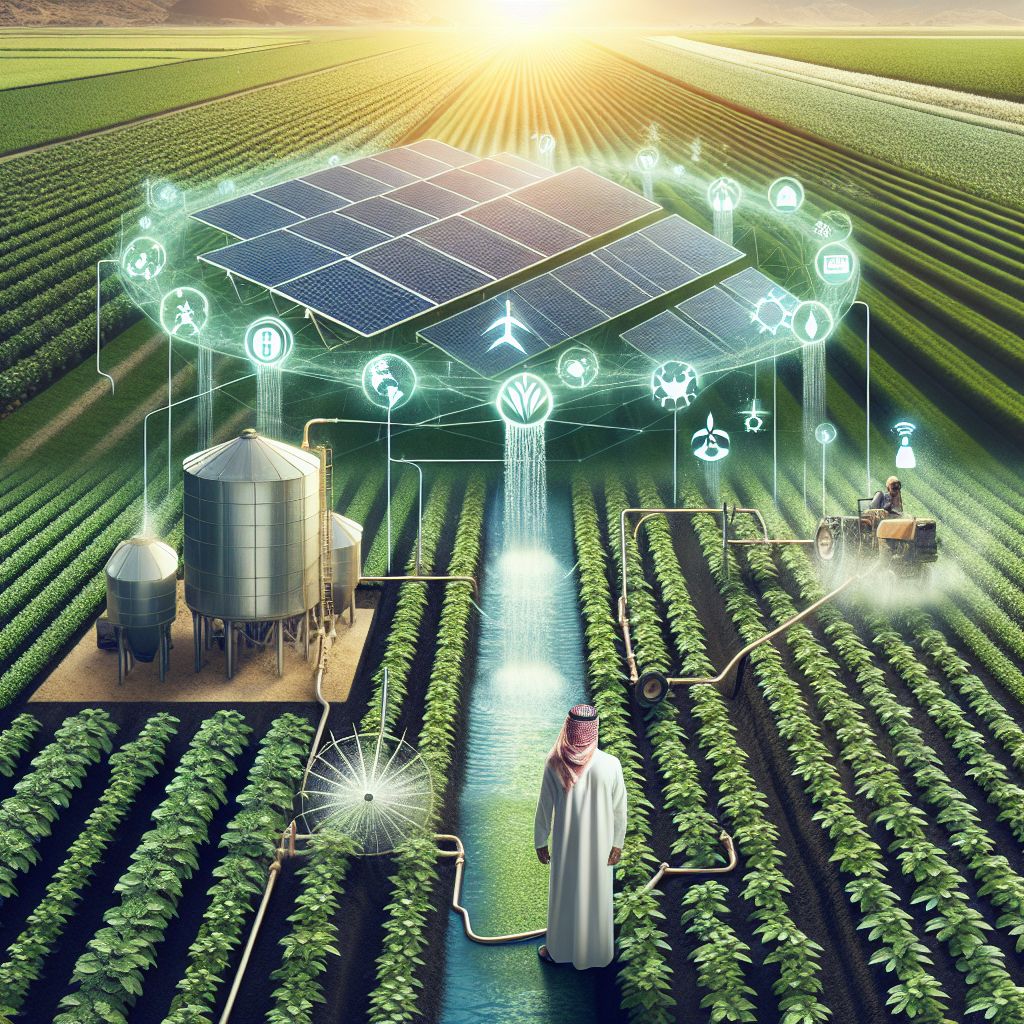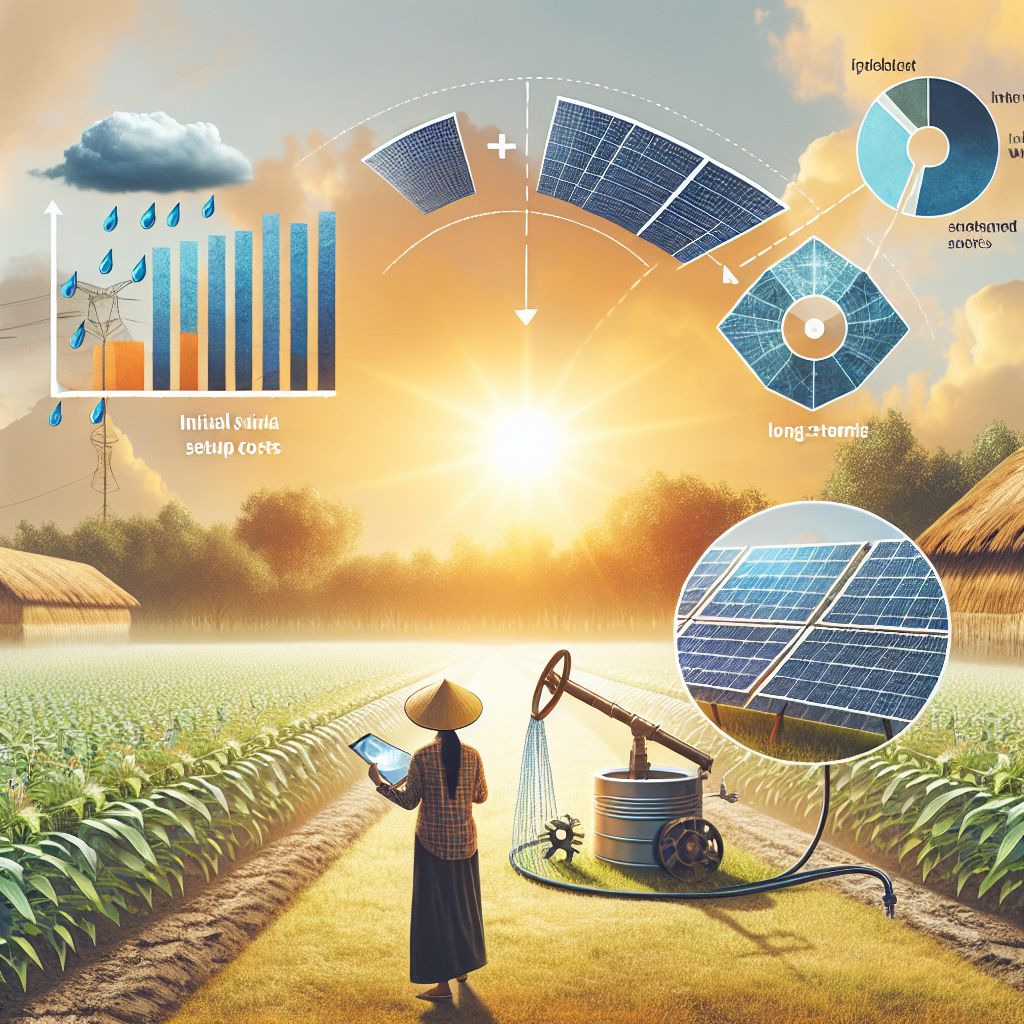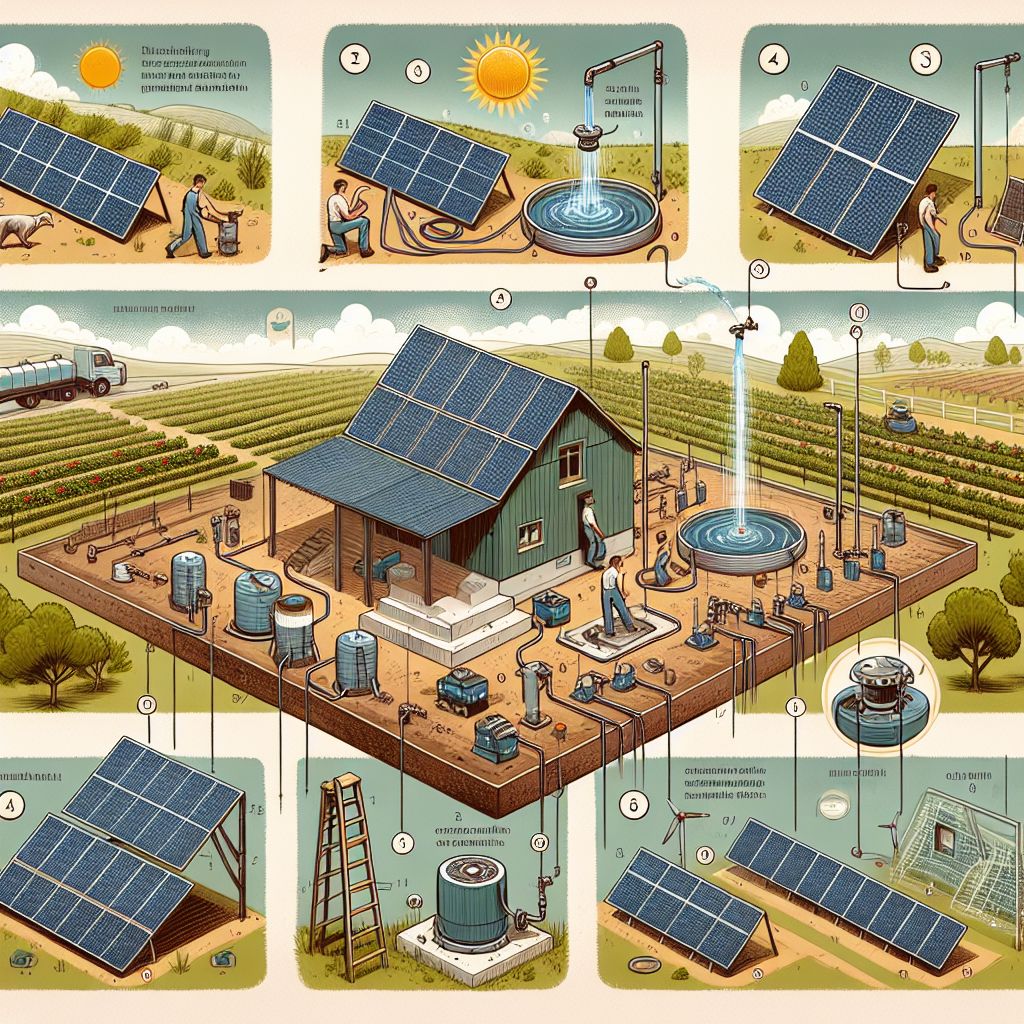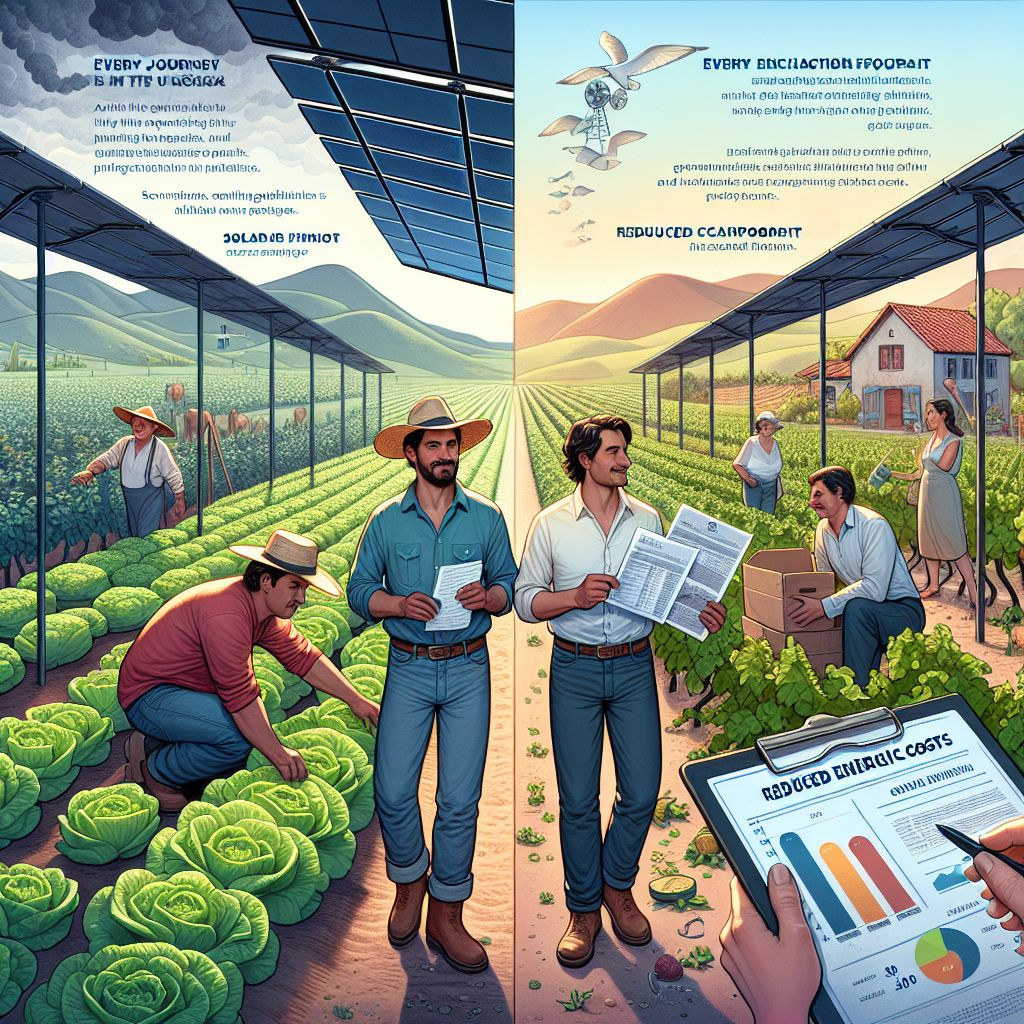
Key Takeaways: Article-at-a-Glance
-
Solar irrigation systems can significantly reduce energy costs, making them a smart financial move for farmers.
-
The initial investment for solar irrigation includes the cost of solar panels, pumps, and installation.
-
Long-term savings from solar irrigation come from lower utility bills and potential government incentives.
-
Assessing your farm’s solar potential is a critical first step before investing in a solar irrigation system.
-
Maintenance of solar irrigation systems is relatively minimal, adding to their cost efficiency.
Why Should Farmers Consider Solar Irrigation Systems?
Irrigation is the lifeline of agriculture, but it can also be a heavy financial burden due to the cost of energy. Imagine slashing those costs and investing that money back into your farm. This is where solar irrigation systems come into play. They harness the power of the sun, a resource we’re blessed with in abundance, to pump water to thirsty crops. This isn’t just about saving money; it’s about taking a step towards sustainable farming practices that will pay off for generations.
Besides that, solar irrigation systems are less reliant on traditional energy sources, which are subject to market fluctuations and can be environmentally damaging. They provide a consistent energy supply that, after the initial setup, has minimal ongoing costs. This makes solar irrigation not just an eco-friendly choice, but a savvy economic decision as well.
Understanding the Financial Aspects of Solar Irrigation
To grasp the full financial picture of solar irrigation, it’s important to look at both the short-term and long-term costs and benefits. Initially, the investment might seem substantial, but when you consider the savings on energy bills and maintenance, the picture starts to look a lot brighter. Over time, solar irrigation systems can pay for themselves and continue to deliver savings for years to come.
Comparing Costs: Solar vs Traditional Irrigation
Let’s break it down. Traditional irrigation systems often run on diesel or electricity from the grid. The cost of diesel fluctuates, and electricity prices are steadily climbing. Solar irrigation, on the other hand, relies on the sun, which sends us its rays for free every day. After the initial setup, the ongoing costs are significantly lower. It usually costs $5,000-$20,000 to set up a small to medium-sized solar irrigation system, depending on the size and complexity, but remember, the sun’s energy comes without a monthly bill.
For example, a farmer in California switched to solar irrigation and saw his energy costs for irrigation drop by 75%. That’s money that can be reinvested in the farm or saved for future needs.
To get a clearer picture, let’s compare two scenarios over a 20-year period, considering the costs of equipment, installation, maintenance, and energy.
| Cost Factor | Traditional Irrigation System | Solar Irrigation System |
| Equipment | – Diesel or electric pump: $500 – $5,000 1, 2, 4 – Piping, valves, and other accessories: $1,000 – $10,000 1, 2, 4 | – Solar panels: $3,000 – $15,000 1, 2 – Pump: $1,000 – $5,000 1, 2, 4 – Accessories (e.g., inverter, batteries): $1,000 – $5,000 1, 2, 4 |
| Installation | $500 – $5,000 1, 2, 4 | $1,000 – $10,000 1, 2, 4 |
| Annual Maintenance | $100 – $500 1, 2, 4 | $50 – $200 1, 2, |
| Annual Energy Costs | $500 – $5,000 (electricity or diesel) 4 | $0 (powered by the sun) 2, 4 |
| Total 20-Year Costs | $12,000 – $120,000 1, 4 | $8,000 – $50,000 1, 4 |
This above table indicates that solar irrigation systems can provide substantial long-term cost savings compared to traditional irrigation systems, with the potential for 20-year total costs to be 50-60% lower.

Breaking Down the Investment
Initial Setup and Equipment Costs
The upfront cost is often the biggest hurdle for farmers considering solar irrigation. This includes purchasing solar panels, a compatible pump, and other necessary equipment, as well as the cost of installation. However, the price of solar technology has been steadily decreasing, making it more accessible than ever. Most importantly, these costs are a one-time investment that leads to decades of energy savings.
Long-Term Savings and Financial Incentives
After the initial investment, the ongoing costs are minimal. Solar panels typically last 25-30 years, and the maintenance required is far less than that of traditional systems. Furthermore, many governments offer incentives for renewable energy adoption, such as tax credits, grants, or rebates, which can significantly offset the setup costs.
Therefore, when considering the switch to solar irrigation, it’s essential to look at the big picture. The savings on energy bills, the potential for government incentives, and the reduced environmental impact all contribute to the financial viability of solar-powered irrigation systems. In the next part of the article, we’ll explore the practical steps for implementing a solar irrigation system on your farm.
Now, let’s get our hands dirty and dig into the nuts and bolts of setting up a solar irrigation system. If you’re committed to sustainable farming, this is a step that not only aligns with eco-friendly practices but also sets you up for long-term financial gains. Before we roll up our sleeves, remember that planning is key. You want to make sure that every piece of the system is tailored to the needs of your farm.
Here is a table outlining the key long-term benefits for using solar irrigation systems on farms. I hope this helps you make a more informed decision.
| Long-Term Benefit | Description |
| Cost Savings | Solar irrigation systems have minimal operating costs, as they are powered by the sun’s free energy rather than expensive fossil fuels. This can lead to significant long-term cost savings for farmers. 1, 4 |
| Sustainability | Solar power is a renewable and clean energy source, unlike fossil fuels which can be depleted and contribute to greenhouse gas emissions. Solar irrigation systems help farms become more environmentally sustainable. 1, 2, 4 |
| Water Conservation | Solar irrigation systems can be integrated with efficient drip irrigation methods, allowing for more precise and targeted water usage. This helps conserve water resources. 1, 2 |
| Longevity | Solar irrigation systems have a long lifespan, with minimal degradation over time. The components may require some replacement, but the system can operate reliably for decades. 1, 4 |
| Government Incentives | Many governments offer tax credits, subsidies, and other financial incentives to encourage the adoption of solar irrigation technology, further improving the long-term economic viability. 1, 4 |
| Energy Independence | Solar irrigation systems provide a reliable source of power for water pumping, especially in remote areas without access to the electrical grid. This energy independence is valuable for long-term farm operations. 2, 4 |
| Improved Productivity | The consistent water supply from solar irrigation can help stabilize, increase, and diversify agricultural production, leading to improved food security and income for farmers over the long run. 2 |
In summary, the long-term benefits of solar irrigation systems for farms include significant cost savings, environmental sustainability, water conservation, longevity, access to government incentives, energy independence, and improved agricultural productivity. These advantages make solar irrigation a smart long-term investment for farmers.

Implementing a Solar Irrigation System
Adopting solar irrigation is a journey, one that involves careful consideration and strategic planning. The goal is to ensure that your system is not only efficient but also effective in meeting the specific irrigation needs of your farm. Let’s walk through the process together.
Step-by-Step Installation Guide
First things first, you’ll need to assess your farm’s solar potential. This means looking at factors like sunlight hours, the angle of the sun, and any potential shading from buildings or trees. You’ll also want to determine the best location for your solar panels to maximize sun exposure throughout the day.
Next, it’s time to choose the right equipment. The size of the solar panel array and the type of pump will depend on the size of your farm and the amount of water you need to move. It’s crucial to select a pump that’s compatible with your solar panels to ensure efficiency.
Once you have your equipment, the installation process begins. This typically involves mounting the solar panels, setting up the pump system, and connecting everything with electrical wiring. It’s often best to work with professionals who have experience in solar installations to ensure everything is set up correctly.
With your system in place, the final step is to test it out. Run the pump, check for any leaks or issues, and make any necessary adjustments. Congratulations, you’re now harnessing the power of the sun to irrigate your farm!
Maintaining Your System for Maximum Efficiency
Keeping your solar irrigation system running smoothly doesn’t require a lot of work, but regular check-ups are key. You’ll want to keep an eye on the solar panels to ensure they’re clean and free of debris, which can block sunlight and reduce efficiency. The pump and other equipment should also be inspected regularly to catch any potential issues early.
The beauty of solar irrigation systems is their simplicity and durability. There are no moving parts in the solar panels themselves, which means they’re pretty low-maintenance. The pump may need some attention from time to time, but as long as you’re proactive, your system should provide reliable service for years to come.

Real Farmers, Real Stories: Case Studies
It’s one thing to talk about the benefits of solar irrigation, but it’s another to see them in action. Let’s look at a couple of real-life examples of farmers who have made the switch and are reaping the rewards.
Success Stories of Solar Irrigation Adoption
In sunny Arizona, a lettuce farmer was struggling with high energy bills during the peak growing season. After switching to solar irrigation, he was able to cut his energy costs by more than half. Not only did this improve his bottom line, but it also provided a more reliable water source for his crops, leading to a better yield.
Another success story comes from a vineyard in France. The owners were passionate about sustainable viticulture and decided to install a solar irrigation system. The move not only reduced their carbon footprint but also saved them money on energy costs, which they reinvested into organic and biodynamic farming practices.
These stories highlight not just the economic benefits but also the positive environmental impact of solar irrigation. When you invest in this technology, you’re not only securing your farm’s future but also contributing to a healthier planet.
Remember: Every farm’s journey to solar irrigation is unique. What works for one farm may not work for another, so it’s important to tailor the system to your specific needs and conditions.
Learning from Challenges Faced and Overcome
Of course, transitioning to solar irrigation isn’t without its challenges. For some, the upfront cost can be a barrier. Others might face technical hurdles, such as integrating the system with existing infrastructure or dealing with less-than-ideal weather conditions.
But these challenges can be overcome with careful planning and support. For example, government incentives can help offset the initial costs, and working with experienced professionals can help navigate technical issues. Most importantly, the farming community is a tight-knit one, and there’s a wealth of knowledge to be tapped into. Don’t be afraid to reach out to other farmers who have gone solar and learn from their experiences.
Final Thoughts on Solar-Powered Sustainability
As we wrap up, it’s clear that solar irrigation is more than just a trend; it’s a practical solution for modern farming. It aligns with the values of sustainability and conservation, which are becoming increasingly important in our world. By investing in solar irrigation, you’re not just securing your farm’s financial future; you’re also taking a stand for the environment.
If you’re on the fence about making the switch, consider the long-term benefits. The cost savings, the environmental impact, and the satisfaction of being energy-independent are compelling reasons to embrace solar-powered water systems. And remember, you’re not alone in this journey. There’s a whole community of eco-conscious farmers out there, ready to share their knowledge and support.
Frequently Asked Questions (FAQ)
Before we part ways, let’s tackle some common questions you might have about solar irrigation.
How Much Can I Save with a Solar Irrigation System?
Savings can vary widely depending on the size of your system and your energy usage, but many farmers see a reduction in their energy bills by 50-80% after switching to solar.
Is My Farm Suitable for Solar Irrigation?
Most farms can benefit from solar irrigation, but it’s important to assess your farm’s specific conditions, such as sunlight availability and water needs, to determine the best setup.
What Is the Lifespan of a Solar Irrigation System?
Solar panels can last up to 30 years, while the pumps and other equipment may need replacement or maintenance over time. With proper care, your solar irrigation system can serve you well for decades.
Can Solar Irrigation Systems Operate in Cloudy Weather?
Yes, they can still function on cloudy days, but their efficiency might be reduced. It’s important to have a battery backup or a grid connection for those less sunny times.
Are There Any Government Subsidies Available for Solar Irrigation?
Many governments offer incentives for renewable energy projects, including tax credits, grants, and rebates. It’s worth looking into the specific programs available in your area.
With these questions answered, you’re now better equipped to make an informed decision about solar irrigation. The sun is a powerful ally for farmers, and with solar irrigation, you can harness its energy for a more sustainable and profitable future.






